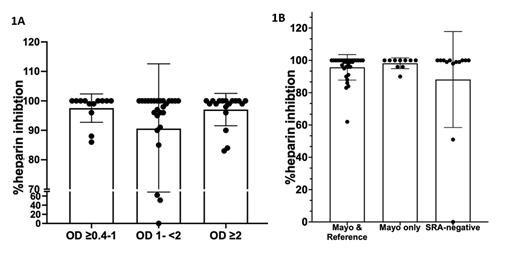Abstract
Introduction:
Heparin-induced thrombocytopenia (HIT) is a potentially life-threatening condition that could occur following exposure to heparin. Accurate and timely diagnosis is critical for appropriate clinical management. Laboratory testing for suspected cases is based on screening for the presence of serum anti-PF4/heparin antibodies using solid-phase enzyme-linked immunosorbent assay (ELSIA) which is known to be sensitive but less specific. A positive ELISA test is followed by functional testing to demonstrate the platelet activating properties and heparin dependence of the pathogenic antibodies. Serotonin release assay (SRA) is considered the gold standard functional test for the diagnosis of HIT. In most anti-PF4/heparin ELISA assays, a high-dose heparin buffer (100U/mL) confirmation step is recommended to demonstrate heparin dependence of detected antibodies and increase the specificity of the assay. The necessity of this confirmation step is controversial with some reports suggesting it could lead to misinterpreting positive ELISA results as negative or indeterminate, especially in cases of very strong and high titer HIT activating antibodies. We hence aimed to investigate the utility of applying this confirmation step as part of an inhouse validation study of a mass spectrometry-coupled SRA (Mayo-SRA).
Materials:
Three hundred archived serum samples were tested using anti-PF4/heparin IgG antibody ELISA (Immucor Diagnostics, GA, USA). High-dose heparin (100U/mL) confirmation step was performed on all samples with OD units ≥0.4 as recommended by the manufacturer. Samples with OD ≥ 0.4 and ≥50% OD inhibition in the high dose heparin confirmation step are interpreted positive. Mayo-SRA results were compared to a reference 14C SRA method. The 4T clinical score was retrospectively calculated for all patient (range 0-8 points).
Results:
Of the 300 tested samples, 57 samples were interpreted positive by the anti-PF4/heparin screening ELISA. 33 of the 57 samples were positive using the reference 14C SRA method, whereas 43 samples were positive by Mayo-SRA assay (≥20% serotonin release). Three additional samples were positive by Mayo-SRA, but negative by both screening ELISA and the reference 14C SRA method. All samples with OD units ≥0.4 displayed >50% inhibition in the high-dose heparin regardless of the intensity of the initial OD value or the HIT 4T score, with the exception of one that was negative by both SRA methods and of 1.35 OD value and 6 4T HIT score (Fig-1A). Importantly, thirteen samples were anti-PF4/heparin positive, but SRA negative (by Mayo-SRA and reference method). These samples also displayed positive %heparin inhibition (≥50% OD inhibition) (Fig-1B). Lastly, there were no differences in the degree of %inhibition in samples positive by both reference and Mayo-SRA or Mayo-SRA only (Fig-1B).
Conclusion:
In our patient cohort, addition of the high dose heparin inhibition confirmation step to the screening anti-PF4/heparin ELISA assay was of no additional diagnostic utility. We hence propose eliminating the heparin inhibition step which would improve laboratory turnaround time, reduce costs, and importantly speed up urgent clinical management decisions.
Figure Legend:
Fig-1A. No correlation between initial OD values and %OD inhibition using high dose heparin. Scatter plot of all ELISA positive samples (OD ≥0.4) grouped according to OD values. Samples include all SRA-positive and thirteen SRA-negative ELISA-positive samples. Fig-1B. Scatter plot of %OD inhibition comparing samples positive by Mayo-SRA and reference SRA method, positive by Mayo-SRA only, and ELISA-positive SRA-negative by both methods.
Pruthi: Bayer Healthcare AG: Honoraria; CSL Behring: Honoraria; Merck: Honoraria; Genentech: Honoraria; HEMA Biologics: Honoraria; Instrumentation Laboratory: Honoraria. Padmanabhan: Veralox Therapeutics: Membership on an entity's Board of Directors or advisory committees.


This feature is available to Subscribers Only
Sign In or Create an Account Close Modal